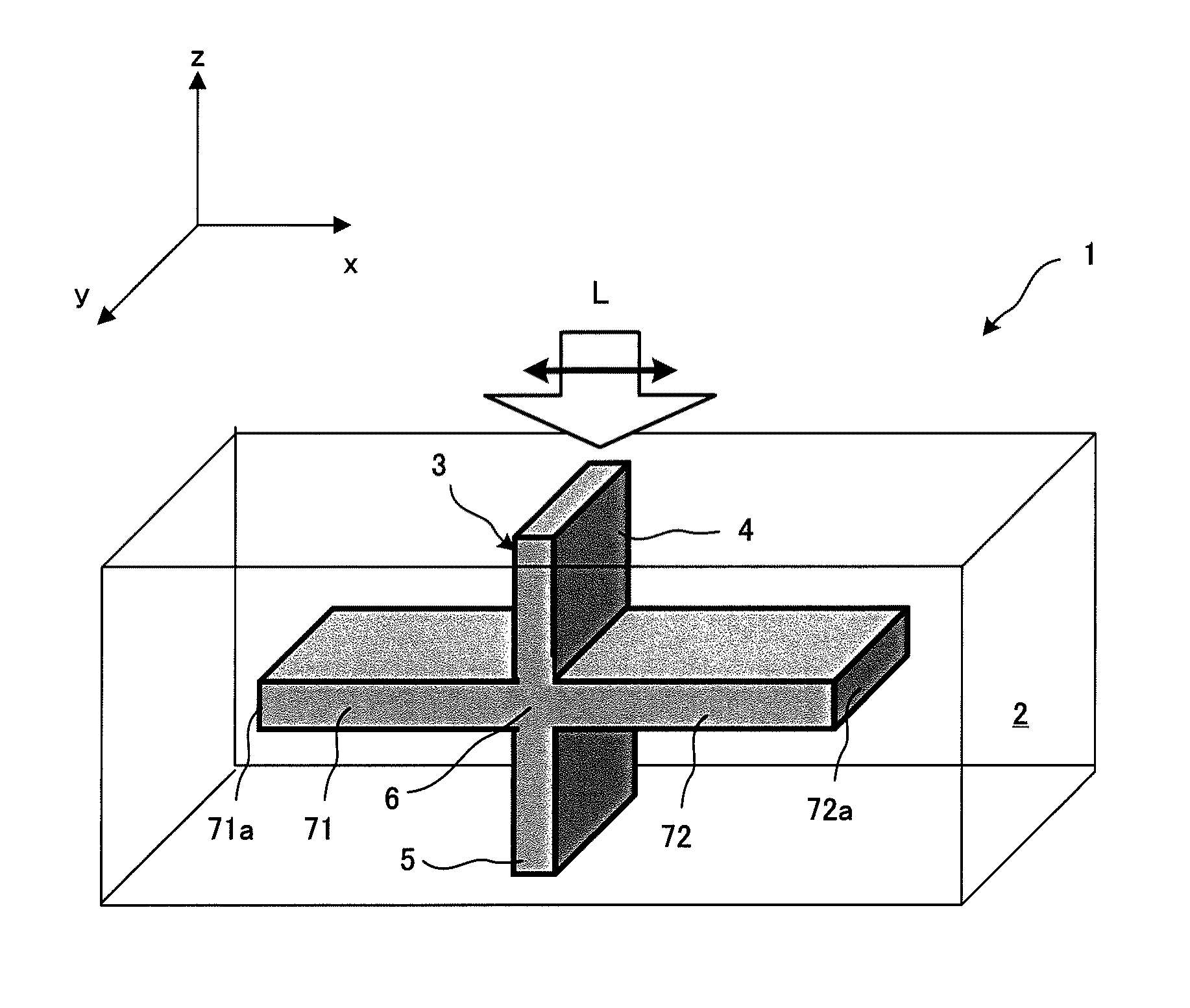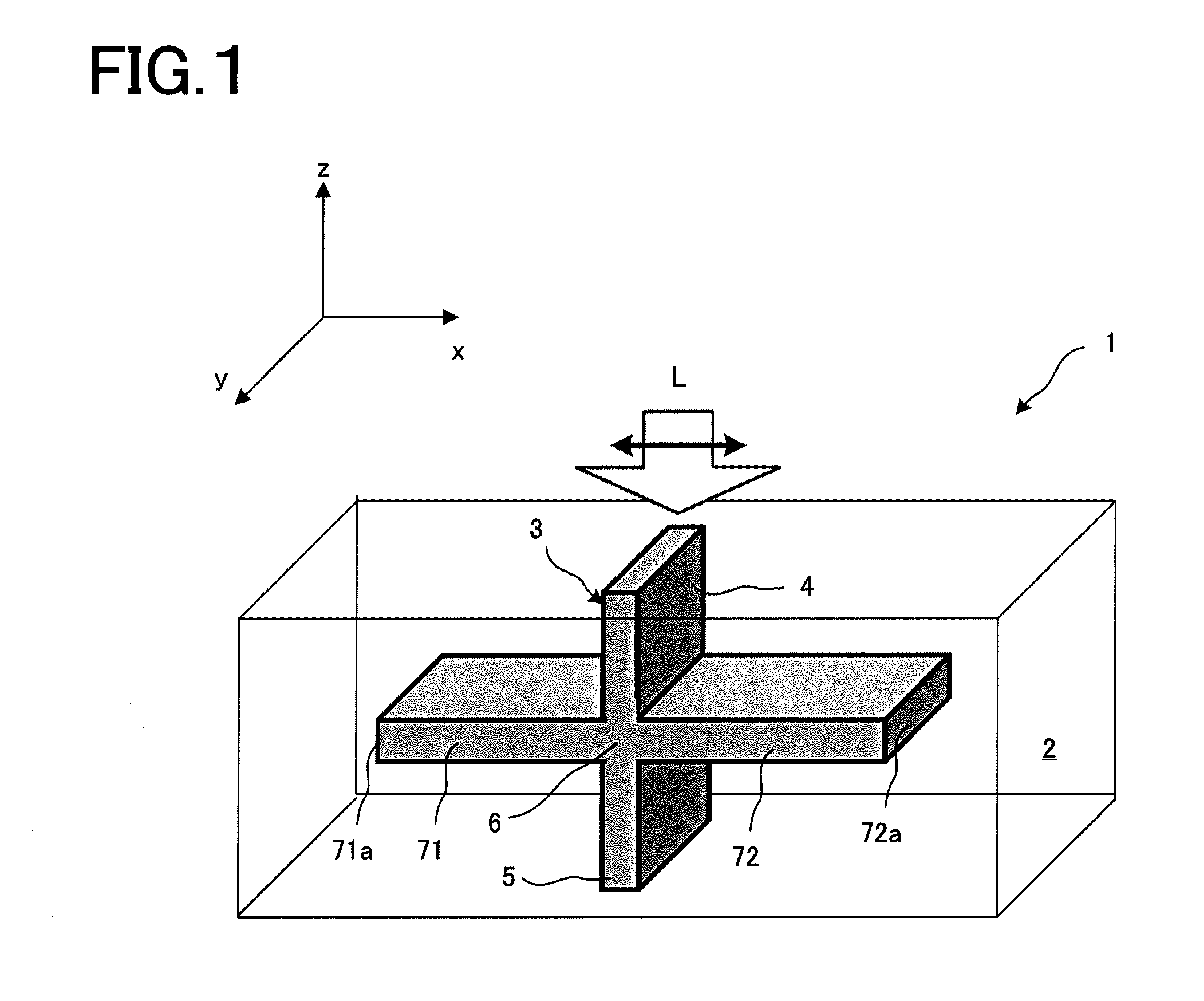Plasmon waveguide and optical element using the same
a technology of optical elements and waveguides, applied in the direction of optical waveguide light guides, instruments, nanotechnology, etc., can solve the problems of large loss, communication difficulty, and the dimension of waveguides cannot be reduced to equal or less than the wavelength used, and achieves simple structure, increased transmittance, and high wavelength selectivity
- Summary
- Abstract
- Description
- Claims
- Application Information
AI Technical Summary
Benefits of technology
Problems solved by technology
Method used
Image
Examples
first embodiment
[0061]The incident-side plasmon waveguide 4 is disposed on the incident side of the light L with respect to the connection portion 6, to which polarized light L is incident. The emission-side plasmon waveguide 5 is disposed on the emission side of the light L with respect to the connection portion 6, from which the light L is emitted. The connection portion 6 connects the incident-side plasmon waveguide 4 and emission-side plasmon waveguide 5. In the first embodiment, the light traveling direction in the incident-side plasmon waveguide 4 and that in the emission-side plasmon waveguide 5 are the same.
[0062]The plasmon interference structure 7 extends from the connection portion 6 in the direction intersecting the incident-side plasmon waveguide 4 or emission-side plasmon waveguide 5 and has a termination 7a at which the light L is reflected.
[0063]The plasmon interference structure 7 of the first embodiment includes a first plasmon interference structure 71 and a second plasmon interf...
second embodiment
[0085]The second embodiment aims to provide a bent plasmon waveguide having a simple structure and small loss.
[0086]FIG. 7 is a perspective view of a plasmon waveguide according to the second embodiment, and FIG. 8 is a cross-sectional view of the plasmon waveguide according to the second embodiment.
[0087]The plasmon waveguide 1 according to the second embodiment includes a cladding 2 made of metal and a dielectric core 3 and provided with an incident-side plasmon waveguide 4, an emission-side plasmon waveguide 5 extending in a different direction from the incident-side plasmon waveguide 4, a connection portion 6 connecting the incident-side plasmon waveguide 4 and the emission-side plasmon waveguide 5, and a first plasmon interference structure 71 and a second plasmon interference structure 72 protruding from the connection portion 6 in the direction intersecting the emission-side plasmon waveguide 4 and incident-side plasmon waveguide 4, respectively, wherein the first plasmon int...
third embodiment
[0112]The third embodiment aims to provide an optical wavelength multiplexer / demultiplexer that can be used in the plasmon waveguide.
[0113]FIG. 13 is a perspective view of the plasmon waveguide according to the third embodiment, and FIG. 14 is a cross-sectional view of the plasmon waveguide according to the third embodiment.
[0114]The plasmon waveguide 1 according to the third embodiment includes a cladding 2 made of metal and a dielectric core 3 and is provided with an incident-side plasmon waveguide 4, a first emission-side plasmon waveguide 51, a second emission-side plasmon waveguide 52, a first connection portion 61 connecting the incident-side plasmon waveguide 4 and first emission-side plasmon waveguide 51, a second connection portion 62 connecting the incident-side plasmon waveguide 4 and second emission-side plasmon waveguide 52, a first plasmon interference structure 71 protruding from the first connection portion 61 in the direction intersecting the incident-side plasmon w...
PUM
 Login to View More
Login to View More Abstract
Description
Claims
Application Information
 Login to View More
Login to View More - R&D
- Intellectual Property
- Life Sciences
- Materials
- Tech Scout
- Unparalleled Data Quality
- Higher Quality Content
- 60% Fewer Hallucinations
Browse by: Latest US Patents, China's latest patents, Technical Efficacy Thesaurus, Application Domain, Technology Topic, Popular Technical Reports.
© 2025 PatSnap. All rights reserved.Legal|Privacy policy|Modern Slavery Act Transparency Statement|Sitemap|About US| Contact US: help@patsnap.com



